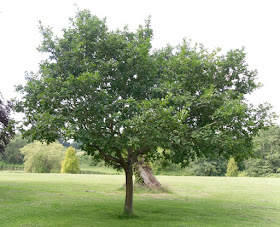Obviously, people tend to miss the obvious, which is one of the reasons why - in all my literary rambles - I've left off looking at Newstead Abbey in Nottinghamshire, which was briefly in the ownership of George Gordon, the sixth Lord Byron (1798-1824), who of course was the famous poet.
He left Aberdeen for Nottinghamshire with his mother at the age of ten, very shortly after the death of his great-uncle William - the 'Wicked Lord' - had resulted in his inheritance, which was some years before Lady Caroline Lamb made the famous 'mad, bad and dangerous to know' remark. And yet, sex was far from unknown to Byron even in his very early Scottish period: his friend John Cam Hobhouse wrote after his death: 'When [Byron] was nine years old at his mother's house a free Scotch girl used to come to bed with him & play tricks with his person'.
'When some proud Son of Man returns to Earth,
Unknown by Glory, but upheld by Birth,
The sculptor’s art exhausts the pomp of woe,
And storied urns record who rests below;
When all is done, upon the Tomb is seen
Not what he was, but what he should have been.
But the poor Dog, in life the firmest friend,
The first to welcome, foremost to defend,
Whose honest heart is still his Master’s own,
Who labours, fights, lives, breathes for him alone,
Unhonour'd falls, unnotic'd all his worth,
Deny'd in heaven the Soul he held on earth:
While man, vain insect! hopes to be forgiven,
And claims himself a sole exclusive heaven,
Oh man! thou feeble tenant of an hour,
Debas'd by slavery, or corrupt by power,
Who knows thee well must quit thee with disgust,
Degraded mass of animated dust!
Thy love is lust, thy friendship all a cheat,
Thy tongue hypocrisy, thy heart deceit,
By nature vile, ennobled but by name,
Each kindred brute might bid thee blush for shame.
Ye, who perchance behold this simple urn,
Pass on, it honours none you wish to mourn,
To mark a friend’s remains these stones arise;
I never knew but one – and here he lies.'
He left Aberdeen for Nottinghamshire with his mother at the age of ten, very shortly after the death of his great-uncle William - the 'Wicked Lord' - had resulted in his inheritance, which was some years before Lady Caroline Lamb made the famous 'mad, bad and dangerous to know' remark. And yet, sex was far from unknown to Byron even in his very early Scottish period: his friend John Cam Hobhouse wrote after his death: 'When [Byron] was nine years old at his mother's house a free Scotch girl used to come to bed with him & play tricks with his person'.
The former priory was dissolved in 1539, and was in the possession of the Byron family for nearly 300 years.
Byron sold Newstead in 1817 to Thomas Wildman, who restored it to some of its former splendor.
Byron's Oak was planted by the poet on his possession of the property, but as it was dying in the first quarter of the 20th century, it was cut down.
To commemorate the 200th anniverary of Byron's birth, the Earl of Lytton, one of his descendants, planted an oak there in 1988.
Byron's beloved Newfoundland dog Boatswain died of rabies in 1808, and Byron erected this monument to him.
'Near this Spot
are deposited the Remains of one
who possessed Beauty without Vanity,
Strength without Insolence,
Courage without Ferosity,
and all the virtues of Man without his Vices.
This praise, which would be unmeaning Flattery
if inscribed over human Ashes,
is but a just tribute to the Memory of
BOATSWAIN, a DOG,
who was born in Newfoundland May 1803
and died at Newstead Novr. 18th. 1808.
'When some proud Son of Man returns to Earth,
Unknown by Glory, but upheld by Birth,
The sculptor’s art exhausts the pomp of woe,
And storied urns record who rests below;
When all is done, upon the Tomb is seen
Not what he was, but what he should have been.
But the poor Dog, in life the firmest friend,
The first to welcome, foremost to defend,
Whose honest heart is still his Master’s own,
Who labours, fights, lives, breathes for him alone,
Unhonour'd falls, unnotic'd all his worth,
Deny'd in heaven the Soul he held on earth:
While man, vain insect! hopes to be forgiven,
And claims himself a sole exclusive heaven,
Oh man! thou feeble tenant of an hour,
Debas'd by slavery, or corrupt by power,
Who knows thee well must quit thee with disgust,
Degraded mass of animated dust!
Thy love is lust, thy friendship all a cheat,
Thy tongue hypocrisy, thy heart deceit,
By nature vile, ennobled but by name,
Each kindred brute might bid thee blush for shame.
Ye, who perchance behold this simple urn,
Pass on, it honours none you wish to mourn,
To mark a friend’s remains these stones arise;
I never knew but one – and here he lies.'
Slightly to the north of Eagle Pond is a dip in the North Terrace wall.
Below this was Forest Pond, called 'American Lake' by the Byrons.
The Rock Garden, with its small stream and 'underground passage', is also known as Venetia's Garden.
This second name has a literary provenance: Benjamin Disraeli's novel Venetia (1837).
The Wicked Lord extended the upper part of the lake and built a cannon fort, from which he played battles using real ammunition.
The mock fort on the opposite side by the former stable block - that is, the same side as the abbey - also played a part in the game.
Following Wildman's death, his widow sold Newstead to William Frederick Webb in 1861, and tourists were allowed into the grounds. In 1931 Nottingham City Council came into possession of Newstead Abbey. Very recently, hours of admission to the house were limited - a far from popular decision.












No comments:
Post a Comment